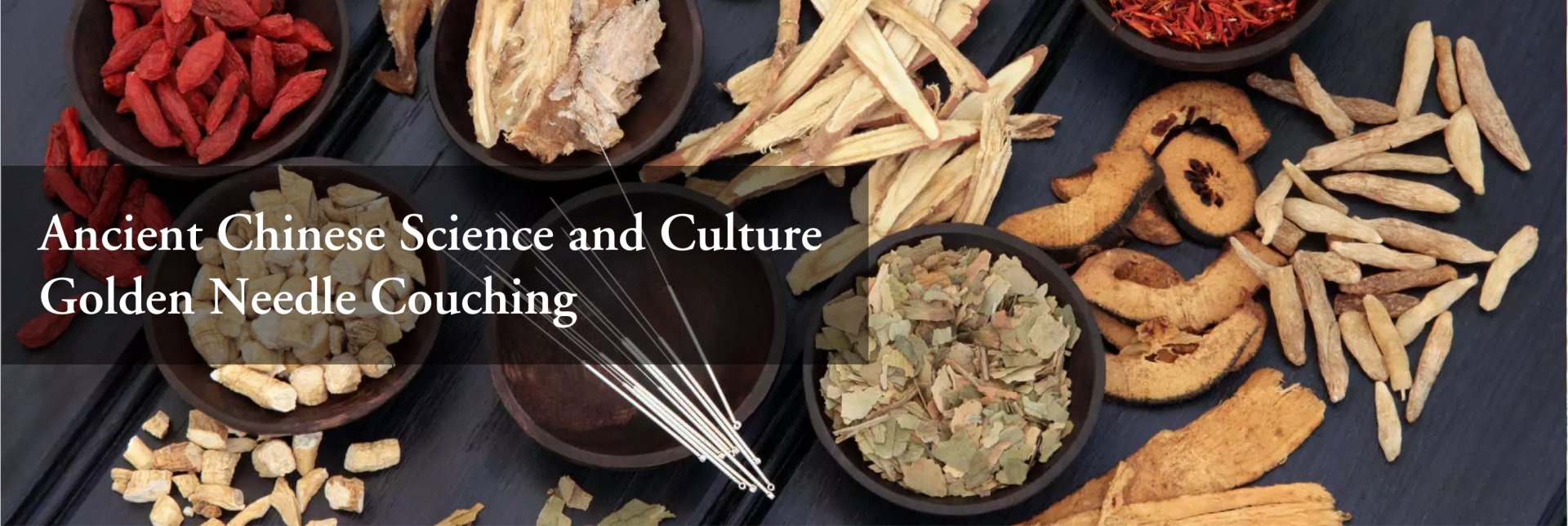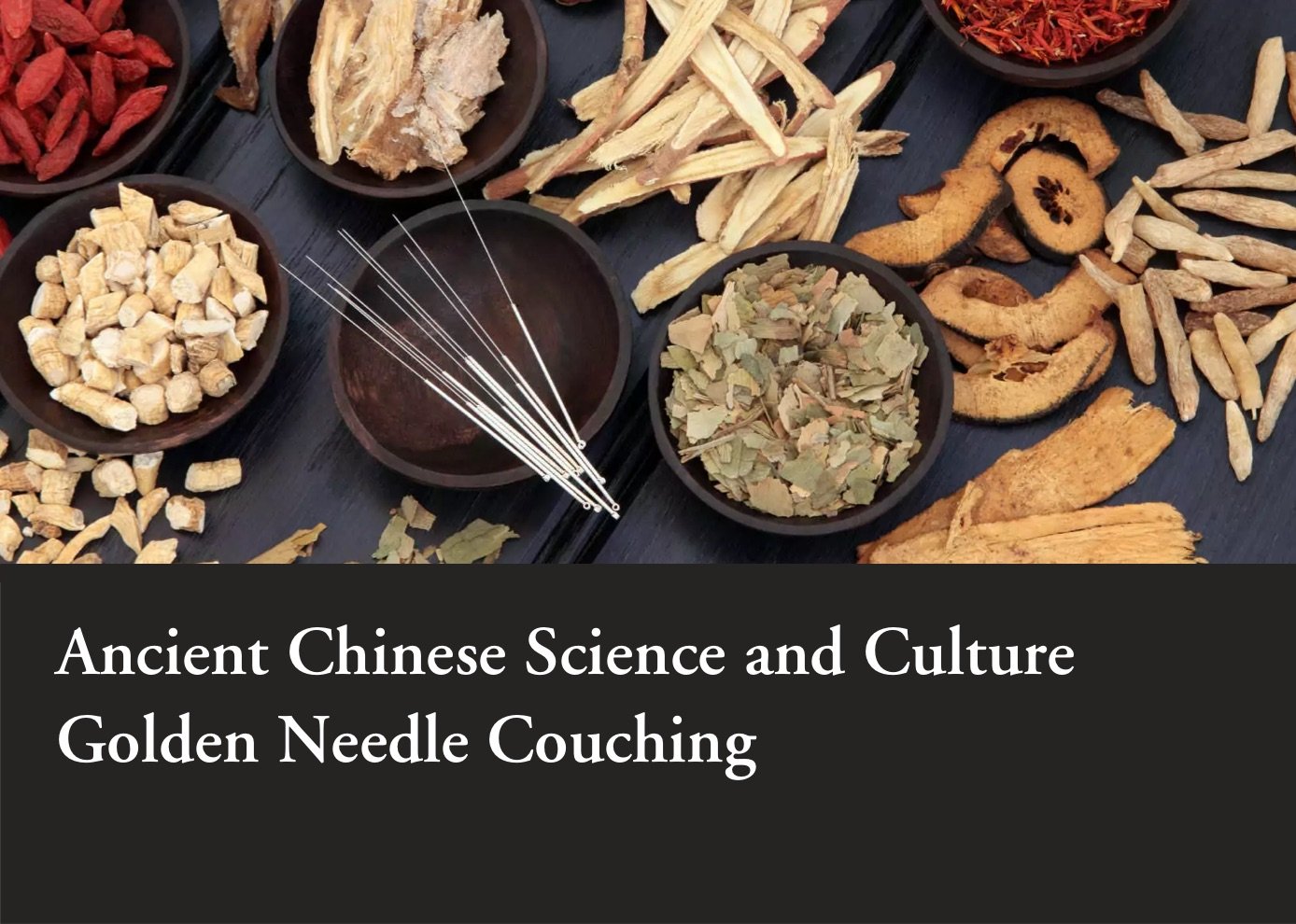Bai Juyi (白居易, 772~846) was a prolific poet in Tang Dynasty (唐朝, 618-690, 705-907) with nearly three thousand poems passed down through the ages, earning him the titles such as “King of Poetry (詩王)” and “The Possessed Poet (詩魔)”.
However, Bai was frail and sickness, “Illness (詠病)” is one of the more prominent themes in his work. Two Poems of My Eye Disease (〈眼病二首〉) described his severe eye condition in his later years, while also reflecting the medical technology and culture of the time: Golden Needle Couching (金針拔瘴術).
The surgery primarily involved piercing the conjunctiva at the corneal margin with a fine needle to reach the vitreous body, and then using a method to displace the cloudy lens, preventing it from floating and obstructing vision.
Two Poems of My Eye Disease
The First
其一
A thousand snowflakes are scattered in the air; and the things in front of me seem to be covered with a layer of gauze.
散亂空中千片雪,蒙籠物上一重紗。
Even when encountering clear weather, it feels like looking at things through a fog; although it is not spring, it seems as if flowers can be seen.
縱逢晴景如看霧,不是春天亦見花。
The monk said it was the dust from the outside world that affected the eyes; while the doctor said it was dizziness caused by liver wind.
僧說客塵來眼界,醫言風眩在肝家。
I have tired both treatment methods have, but there has been no improvement; the medication is weak, and the power of Buddhism also seems distant.
兩頭治療何曾瘥,藥力微茫佛力賒。
The Second
其二
The eye disease has been present for a long time; and the root of the problem is deep and difficult to remove.
眼藏損傷來已久,病根牢固去應難。
The doctor advised me to quit drinking first; while my friends advised me to resign from my official position early.
醫師盡勸先停酒,道侶多教早罷官。
The "Introduction to Ophthalmic Diseases" is casually spread out on the table; and the medicine box is empty of Jueming Pills.
案上謾鋪龍樹論,盒中虛捻決明丸。
It seems that the remedies in the world have no effect; I really want to try using the golden needle to scrape and treat it
人間方藥應無益,爭得金篦試刮看?
Bai describes in his poem that he suffers from a serious eye disease and has sought solutions multiple times to alleviate the symptoms of unclear vision. From the verses, it seems he may have sought help from both monks and doctors. " The monk said it was the dust from the outside world that affected the eyes (僧說客塵來眼界)," where " the dust from the outside world (客塵)" is a Buddhist term referring to external troubles that pollute the mind, contrasting with "pure nature (自性清淨)." The so-called eye disease is actually the result of being tainted by the pains of worldly gains and losses. The doctor explains with traditional Chinese medicine theory that the root of Bai’s eye diseases lies in the liver, and excessive drinking can harm the liver, so in the poem, the doctor advised him to stop drinking, as liver and kidney deficiency can lead to eye diseases.
It was mentioned in the second poem that Bai hope to find the treatment plan from the "Nāgārjuna’s Introduction to Ophthalmic Diseases (《龍樹論》, also called as《龍樹菩薩眼論》)," the book was regarded as the first ophthalmology treatise in China, but the original text has been lost. The "The Secret Book of Nāgārjuna’s Introduction to Ophthalmic Diseases," completed in 1575, is considered the earliest existing ophthalmology treatise in China, believed to have been passed down after being supplemented or compiled with other medical texts by the physicians of Song dynasty (宋朝, 960-1279) and Yuan dynasty (元朝, 1271-1368) based on "Nāgārjuna’s Introduction to Ophthalmic Diseases."
“龍樹” in Sanskrit is " Nāgārjuna". Many people in India are called Nāgārjuna, and historically notable figures named Nāgārjuna include early Mahayana Buddhist (大乘佛教) masters, later referred to as "Bodhisattva Nāgārjuna (龍樹菩薩)," who lived around the 2nd or 3rd century in South India. As for the medical texts bearing the name " Nāgārjuna," they originate from Indian medical practices. Religion and medicine serve as carriers of cultural exchange between different regions. Even modern medicine in recent times has come to China through the medium of religion. The Swiss missionary doctor Jean Terrenz (鄧玉涵, 1576-1630) was the first Western missionary doctor to arrive in Macau (澳門) in 1621. During his time in China, in addition to spreading the religious doctrines he believed in, he also translated medical physiology books such as "Outline of Western theories of the human body (《泰西人身說概》)" and "Illustrations of the Human Body (《人身圖說》)," marking the beginning of the introduction of modern medicine (Western medicine) to China.
The “golden needle” in the second poem refers to Traditional Technique for Couching Cataracts, this medical technique for treating eye ailments was introduced to China by Buddhist monks. “History of the Southern Dynasties (《南史》)” and “Book of Liang (《梁書》)” all detailed that the ninth son of Emperor Wu of Liang (梁武帝蕭衍, 464-549), Xiao Hui (蕭恢, 476-526)’s story, " Later, Xiao Hui developed an eye disease and eventually went blind. A monk named Huilong (慧龍) had a method to treat eye diseases, so Xiao Hui asked him to cure him… After Huilong administered the treatment by the needle, Xiao Hui regained his sight once again (有目疾久廢視瞻。有道人慧龍,得療眼術,恢請之……及慧龍下針,豁然開朗).," so Bai's high hopes for " Golden Needle Couching " are well-founded.
The four ancient civilizations: Babylon, Egypt, China, and India are the places where human civilization and culture first emerged. All four civilizations were established near river valleys, with relatively distant geographical locations, but only China and India share a border. Despite being separated by the Himalayas, there has been interaction between the two for thousands of years. Buddhism originated in India and, after being transmitted to China, initially spread only in small amounts within the court due to the differing cultural backgrounds of China and India, resulting in very limited social influence. During the Wei, Jin, and Northern and Southern Dynasties, long-term social turmoil provided an opportunity for the development of Buddhism. In the process of integrating into Chinese society, Buddhism included the treatment of diseases as part of its practice, leading to Indian medical knowledge becoming a part of Chinese medicine.
The medical literature of the Tang Dynasty does not clearly record the specific methods of the "Golden Needle Couching". until "The Prescription by Emperor's Grace (《太平聖惠方》)" that there was a detailed introduction, which described the patient's posture during the surgery and pointed out the need for different weights when inserting the needle, among other procedures. However, the "Golden Needle Couching" has not been promoted. In the Ming Dynasty (明朝, 1368-1644), the physician Zhang Jiebin (張介賓, 1563–1642) wrote in "Jingyue’s Medical Encyclopedia (《景嶽全書》, “景嶽” [Jingyue] is the courtesy name of Zhang Jiebin )": "I have heard of skilled physicians who can use a gold needle to push away the clouds in the black eye, and this method is the most effective. Although I have heard of it, I have never seen anyone who possesses this skill (又聞有巧手妙心,能用金針於黑眼內撥去雲霧,取效最捷者,此雖聞之,而實未見其人也 翻譯為現代文)." In India, the "Golden Needle Couching" has even disappeared without a trace. However, in the land of China, wisdom is hidden in the folk, and it has not been completely lost.
In July 1975, after two expanded meetings of the Political Bureau of the Central Committee of the Communist Party of China, a discussion was held regarding the treatment plan for the then highest leader of China, Chairman Mao, for cataract surgery using either traditional Chinese medicine or Western medicine. It was decided that Dr. Tang Youzhi (唐由之, 1926-2022) would lead the procedure, using the traditional Chinese medicine technique of "Golden Needle Couching". When Dr. Tang introduced the "Golden Needle Couching" to Chairman Mao, who had a deep interest in Chinese literature, he quoted Bai Juyi's poem "Two Poems of My Eye Diseases" to explain it. As a result, the surgery was successfully completed in just five minutes. After the surgery, Dr. Tang and the medical team asked Chairman Mao, "Chairman, can you see clearly?" Chairman Mao was extremely pleased and repeatedly said, "Clear! Clear!" In the 1980s, this "Golden Needle Couching" technique was brought back to India by Chinese doctors. In 1981, a traditional Chinese medicine investigation team, composed of six members including Dr. Tang Youzhi, then Vice President of the China Academy of Traditional Chinese Medicine, visited India and watched a documentary brought by the Chinese team with over a hundred Indian medical experts from the Traditional Indian Medicine Research Institute. This documentary recorded the situation of Chinese doctors performing " Golden Needle Couching" surgery, confirming the revival of this ancient skill.
All articles/videos are prohibited from reproducing without the permission of the copyright holder.




Welcome to leave a message:
Please Sign In/Sign Up as a member and leave a message